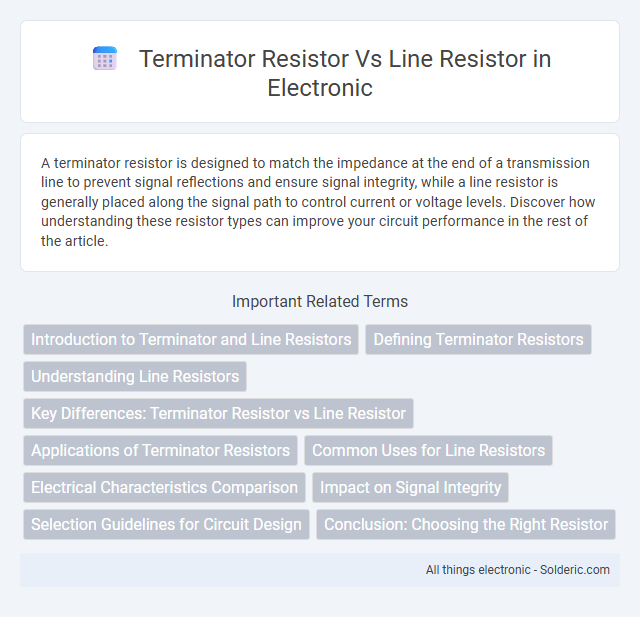A terminator resistor is designed to match the impedance at the end of a transmission line to prevent signal reflections and ensure signal integrity, while a line resistor is generally placed along the signal path to control current or voltage levels. Discover how understanding these resistor types can improve your circuit performance in the rest of the article.
Comparison Table
| Feature | Terminator Resistor | Line Resistor |
|---|---|---|
| Purpose | Terminate transmission lines to prevent signal reflections | Limit current and adjust signal levels on transmission lines |
| Placement | At the end of a transmission line | Along the transmission line or near the signal source |
| Resistance Value | Matches characteristic impedance (e.g., 50O, 75O) | Varies based on circuit requirements (typically from a few ohms to hundreds) |
| Function | Absorbs signal energy to prevent reflections and signal distortion | Controls signal amplitude and current flow |
| Application | High-speed data lines, RF circuits, communication buses | Signal conditioning, noise reduction, current limiting |
| Impact on Signal Integrity | Improves signal integrity by matching impedance | May introduce signal attenuation depending on resistance value |
| Common Types | Fixed value resistors designed for impedance matching | Various fixed or variable resistors depending on application |
Introduction to Terminator and Line Resistors
Terminator resistors are used to match the impedance at the end of transmission lines, preventing signal reflections and ensuring data integrity in high-speed communication systems. Line resistors, positioned along the transmission line, control signal amplitude and limit current to protect components while maintaining signal quality. Understanding the specific roles of these resistors helps optimize your electronic circuit's performance and reliability.
Defining Terminator Resistors
Terminator resistors are precision resistors placed at the end of transmission lines to match the characteristic impedance and prevent signal reflections that cause data corruption. Unlike line resistors, which control current or voltage levels within a circuit, terminator resistors ensure signal integrity by absorbing energy and maintaining proper waveform shape. Understanding terminator resistor value and placement is crucial for optimizing high-speed digital communication systems and improving Your device's reliable operation.
Understanding Line Resistors
Line resistors help control current flow and signal integrity in electrical circuits by adding resistance along a conductor. Unlike terminator resistors, which are placed at the end of a transmission line to prevent signal reflections, line resistors are distributed within the line to reduce noise and improve overall circuit performance. Understanding the function of line resistors enables you to optimize your circuit design for better stability and reliability.
Key Differences: Terminator Resistor vs Line Resistor
Terminator resistors are specifically designed to match the impedance of transmission lines, preventing signal reflections and ensuring data integrity in high-frequency communication systems. Line resistors, however, primarily function to limit current and distribute voltage along a circuit without the critical impedance matching role. The key difference lies in the terminator resistor's role in impedance matching for signal transmission, whereas line resistors serve general current control and voltage division purposes.
Applications of Terminator Resistors
Terminator resistors are primarily used in high-speed data communication systems such as CAN bus, SCSI, and RS-485 networks to prevent signal reflections and ensure data integrity. Unlike line resistors that primarily limit current, terminator resistors match the impedance of transmission lines at the cable terminus, minimizing signal distortion. To optimize your system's performance, correctly placed terminator resistors help maintain reliable communication by stabilizing voltage levels and reducing electromagnetic interference.
Common Uses for Line Resistors
Line resistors are commonly used for current limiting, signal conditioning, and noise reduction in communication lines and sensor circuits. Unlike terminator resistors, which match impedance to prevent signal reflections, line resistors help stabilize voltage levels and protect components from voltage spikes. These resistors are vital in applications such as LED arrays, analog signal lines, and input/output ports to ensure consistent performance and device safety.
Electrical Characteristics Comparison
Terminator resistors typically have a fixed resistance value, often 120 ohms, designed to match the characteristic impedance of transmission lines and minimize signal reflections. Line resistors, in contrast, may vary widely in resistance and are primarily used for current limiting or voltage division rather than impedance matching. Your choice between them impacts signal integrity and noise reduction in high-speed communication systems.
Impact on Signal Integrity
Terminator resistors are critical for maintaining signal integrity by matching the impedance at the end of a transmission line, effectively minimizing reflections and signal distortions. Line resistors, placed inline, primarily control current flow and voltage levels but do not significantly address impedance mismatches or signal reflections. Proper use of terminator resistors reduces noise and improves signal clarity, especially in high-speed digital circuits, while line resistors mainly impact signal amplitude and power consumption.
Selection Guidelines for Circuit Design
Terminator resistors are critical for preventing signal reflections and ensuring impedance matching in high-frequency transmission lines, while line resistors are primarily used for current limiting or voltage division within circuits. When selecting between terminator and line resistors, consider the characteristic impedance of your transmission line (typically 50O or 75O) and ensure the terminator resistor value matches this impedance for optimal signal integrity. Your circuit design should also account for power rating, tolerance, and resistor type to maintain reliable performance and minimize signal distortion.
Conclusion: Choosing the Right Resistor
Choosing the right resistor depends on the specific application requirements, where terminator resistors are essential for minimizing signal reflections in high-frequency transmission lines, ensuring signal integrity. Line resistors, by contrast, primarily serve to limit current and protect circuit components, making them suitable for general-purpose use in electrical circuits. Evaluating the role of signal stabilization versus current control is crucial in selecting an appropriate resistor type for effective circuit performance.
terminator resistor vs line resistor Infographic

 solderic.com
solderic.com